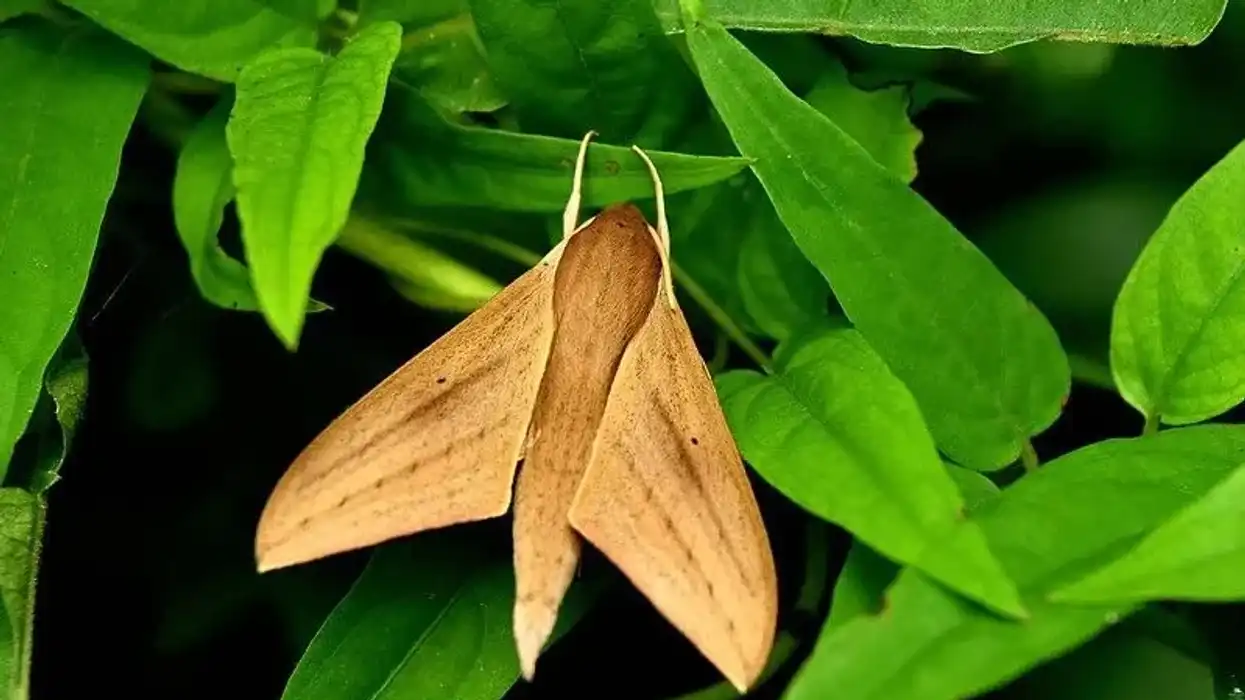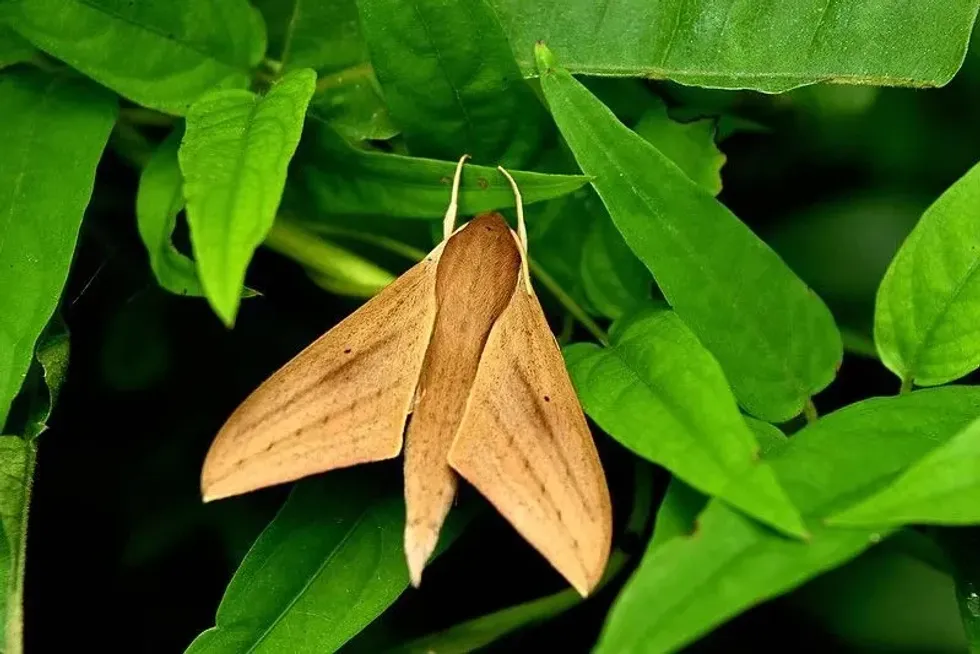Do you like reading about butterflies and moths?
The tersa sphinx moth (Xylophanes tersa) is an iconic species that is easily recognized by its dark brown or black coloration with cream or yellow stripes along the abdomen. The tersa sphinx moth is one of the largest species of sphinx moths in North America, with a wingspan of up to 8 in (20.3 cm).
The tersa sphinx moth (Xylophanes tersa) is a moth of the genus Xylophanes It is a nectar feeder and its larvae feed on the various plant families such as Moraceae including American Hornbeam (Carpinus caroliniana), American Beech (Fagus grandifolia), and European Beech (Fagus sylvatica).
The tersa sphinx moth is a nocturnal species and is attracted to light. It feeds on a variety of plants and trees. The tersa sphinx moth range is believed to be distributed in the United States, Central America, and Mexico, South America.
It is also found in the western and southern parts of North America. It is found in wooded areas and urban gardens. This moth feeds on a variety of plants and trees.
If you want to read more about such fascinating animals, then make sure to take a look at the five-spotted hawk moth and plume moth.
Tersa Sphinx Moth Interesting Facts
What type of animal is a tersa sphinx moth?
Tersa sphinx moth (Xylophanes tersa) is a member of the family Sphingidae of the Animalia kingdom. The order of tersa sphinx moth is Lepidoptera.
What class of animal does a tersa sphinx moth belong to?
Tersa sphinx moth (Xylophanes tersa) belongs to the class of Insecta.
How many tersa sphinx moths are there in the world?
There is no exact estimation of their population, however, they are very commonly seen lingering throughout the flower gardens. Moreover, there are two known subspecies namely, Xylophanes tersa chaconi and Xylophanes tersa tersa.
Where does a tersa sphinx moth live?
This South American species is common in the south of the United States and is found in all the states of the coastal plains.
It is found throughout the eastern and central United States, the Midwest, in the Rocky Mountains, and into the western parts of the United States including throughout the cities of Massachusetts, Nebraska, Florida, and southern Arizona.
One of the occasional strays can also be found in parts of South America, New Mexico, North Carolina, and prominently to the west of Bolivia, Brazil, Argentina, and Paraguay.
What is a tersa sphinx moth's habitat?
The tersa sphinx moth (Xylophanes tersa) has a natural habitat of moist deciduous forests but has adapted well to suburban areas, parks, and gardens. It is found in the flower gardens of the southern United States, Central America, West Indies, and Mexico.
Who do tersa sphinx moths live with?
There is very little information available on their living habits.
How long does a tersa sphinx moth live?
It is observed that they can live for around 10-30 days.
How do they reproduce?
The life cycle of the tersa sphinx moth (Xylophanes tersa) starts with eggs being laid on the underside of the leaves of the food plant. The eggs or larvae are laid in clusters, usually with one egg per leaf.
After the tersa sphinx moth hatching occurs, the caterpillar will eat its eggshell. The caterpillar will grow until it is ready to pupate. The caterpillar will attach itself to the underside of a leaf or some other object.
The pupa will last about two weeks, then the adult moth will emerge. The female adults lay around 1000 eggs on the leaves of the host plants.
In the spring it emerges from the pupa and becomes a moth. In the summer it mates and lays eggs on the leaves of a variety of plants. In the fall it enters a period of dormancy. In the winter it emerges from dormancy and becomes a moth again.
What is their conservation status?
Their conservation status is Not Listed, however, they are very commonly seen in parks and flowers gardens which means they are not undergoing any serious population threats.
Tersa Sphinx Moth Fun Facts
What do tersa sphinx moths look like?
The identification of the adult tersa sphinx moth (Xylophanes tersa) can be done by its pale gray moth with red and dark brown striping on the hindwing ad abdomen area. The tersa sphinx moth has a single, narrow, dark brown stripe running across the forewing, which is also pale gray.
The tersa sphinx moth has a wingspan that ranges from 3-5 in (7.6-12.7 cm). These moths' upperside of the forewing is very striking, as they are pale and gray in coloration.
The upper side of their wings has continuous band patterns of white. The identification of the caterpillar can be done by its primarily green color.
How cute are they?
Tersa sphinx moth (Xylophanes tersa) is adorable, however, many might not like them because of their destructive habits, like a gypsy moth.
How do they communicate?
Tersa sphinx moth (Xylophanes tersa) mainly communicates through chemical channels. Interestingly, they do not have any hearing organs so they are not used to producing any sort of sounds. They use pheromones to communicate with each other.
Pheromone is a chemical substance that is secreted by insects in order to convey their message. Generally, a pheromone is used to attract opposite sexes in insects. However, different combinations of chemicals in the pheromone may produce different actions.
How big is a tersa sphinx moth?
The tersa sphinx moth is comparatively decent in size and is delicate like all other moth species. They are almost 1.3-6.1 in (3.2-15.5cm) in size, with their wingspan ranging between 7.6-12.7 cm (3-5 in). They are bigger than a puss moth.
How fast can tersa sphinx moths fly?
These moths are fast fliers and they can fly comparatively faster than some other species. However, no appropriate speed is known to answer their flight speed.
How much does a tersa sphinx moth weigh?
As all other moth species, these pale gray moth creatures are not weighed and measured. However, they are very delicate and light for very obvious reasons.
What are their male and female names of the species?
The tersa sphinx moth is not distinguished on the basis of their respective sexes. Hence, it is simply known as the tersa sphinx moth male and female.
What would you call a baby tersa sphinx moth?
A baby tersa sphinx moth is called a sphinx caterpillar. Tersa sphinx moth caterpillar is green in color.
What do they eat?
The tersa sphinx caterpillar is a voracious feeder and feeds on the foliage of ash, lilac, privet, cherry, and other woody plants. Mainly, the tersa sphinx moth's food consists of nectar from various host plants.
Apart from that, the tersa sphinx moth caterpillars might also consume plant sap as their primary food.
The caterpillars are known to feed on the nectar of a huge variety of host plants namely, Pentas (starclusters), Catalpa, Smooth buttonplant (Spermacoce glabra), Borreria, Hamelia patens, Manettia, Heimia salicifolia, and Inga vera. The adults might range from several flowers to host plants such as Lonicera, Chinese violet (Asystasia gangetica), and Mirabilis jalapa.
Are they dangerous?
No, they are not dangerous nor poisonous. They do not bite either. However, it is seen that the young green tersa sphinx moth caterpillar might harm some plantations at times. Henceforth, they are observed as a very serious problem causing insects by the folks especially the tomato plantations are seriously harmed by them.
Would they make a good pet?
No, just like a luna moth, these pale gray creatures would not make good pets, however, they are known as great pollinators. Therefore, the adults are often attracted to gardens on purpose.
They might also annoy and destroy the plantations, hence many want to remove or kill them anyway. To get rid of these, an insecticide would be of great help.
Did you know...
The tersa sphinx moth is a nocturnal species and is attracted to light.
Why are they called tersa sphinx moths?
The tersa sphinx moth (Xylophanes tersa) is named after Tersa, a nymph in Greek mythology who was transformed into a moth.
How long does a tersa sphinx moth stay in the cocoon?
The eggs hatch in two to three weeks and the larvae emerge. The larvae will quickly consume all the leaves and pupate in the soil.
The pupa will remain in the soil for two to three weeks before emerging as an adult. Therefore, the tersa sphinx moth stays in the tersa sphinx moth cocoon for almost two to three weeks before they emerge.
Here at Kidadl, we have carefully created lots of interesting family-friendly animal facts for everyone to discover! For more relatable content, check out these puss moth facts and American dagger moth facts for kids.
You can even occupy yourself at home by coloring in one of our free printable moth coloring pages.
Thank you to Kidadler Justin Parker for providing the image of the Tersa Sphinx Moth in this article.









